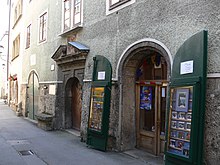Pfeifergasse (Salzburg)
The Pfeifergasse is a winding alley in the old city of Salzburg . It leads from Mozartplatz to Kajetanerplatz and was formerly called Webergasse after the linen weavers who also lived there . Only the easternmost part was previously known as Kumpfmühlgasse. The Pfeifergasse was the street of the minstrels and professional musicians. Under whistles were namely musicians (minstrels) in general and woodwind instrument players in the municipal service in particular. A "Spielgraf", an office that was first mentioned in a document in Salzburg in 1488, was in charge of the Pfeifer. The name is derived from Chunrat Amayßl , who was the head of the Salzburg city pipers at the beginning of the 16th century.
Well-known buildings
Stumpfeggerhaus (Sebastian-Stief-Haus, master mason house)
(Pfeifergasse 4)
This house, which is first mentioned on the occasion of the sale to the Society of Priests in 1438, was owned by the well-known master builder Sebastian Stumpfegger in 1680 . He was followed by the formerly well-known master masons He and Karlsdorfer as owners, and in 1858 the well-known painter Sebastian Stief is the owner. The marble relief above the entrance portal shows the crucifixion of Jesus (1530) and probably comes from a tombstone in the nearby cathedral cemetery. The nearest small alley is named after Sebastian Stief.
Papagenoplatz and Papageno Fountain
Papagenoplatz was created by heavy bombing on October 16, 1944, when 244 deaths were reported in the area around Pfeifergasse and Kaigasse. Today there is a fountain there that was created in 1960 by the Salzburg sculptor Hilde Heger . The fountain is decorated with a statue of the most popular figure in the Mozart operas: the bird catcher Papageno from the Magic Flute . The figure is closely related to the old figure of the Salzburg Hanswurst . The well-known Mozart interpreter and Salzburg connoisseur Bernhard Paumgartner counted this fountain among the loveliest monuments in the city.
Rapplbad
The Raplbad (also called Rappelbad or Altes Baderhaus) was once located on the site of the adjacent house No. 9, which was first mentioned in a document in 1304, when the Bishop of Seckau gave the bath and Kumpfmühle to the cathedral chapter. The “Bader” employed there was a lifeguard, hairdresser and doctor in one person. In 1384 a Rappl was active here as "Pader zu Salzburg". An essential place of work for Paracelsus , who worked with these bathers, was also located here. That Rapplbader, who is mentioned in Paracelsus' will, was also called Rappl by surname, since the Rappl families owned the baths for several generations until 1549. Badly damaged by American aerial bombs in 1944, the house was rebuilt in 1962-64 in the then contemporary style, but the facade design was soon largely adapted to the medieval structure.
Kumpfmühlhaus
(Pfeifergasse 11)
This house, built directly onto the city wall of the second city fortification, is particularly well preserved in its medieval substance. Some of the windows still have original Gothic reveals. The eponymous mill, which can be traced back to the 14th century, was operated with water from the Alm Canal, which still flows under the house with pipes. The mill was built around 1000 and had an undershot water wheel, which was commonly called the Kumpfmühlrad.
Theophrastus Bombastus von Hohenheim, known as Paracelsus, lived here before his flight from Salzburg in 1525. Behind the large, but now inconspicuous round arched portal of the house, hides the remainder of a once magnificently designed Salzburg city gate, the Kumpfmühltor (a watering gate with access to the banks of the Salzach) Time of the second city fortification. This gate once had a representatively designed crenellated gate tower. In 1645 Paris Lodron closed this gate by introducing a new, stronger city wall. Today, however, there is a small door in the Lodron city wall. Major parts of the gate including the gate tower were demolished in 1873.
Circle host
(Pfeifergasse 14)
There has been evidence of an inn here since 1595, in 1647 the restaurant was called Gulden Zirkhl , and in 1686 at Golden Zjerggl . Because of the archbishop's monopoly of beer, beer was served from the Kalten Brauhaus am Kai and later from the Hofbräu Kaltenhausen . The house was completely destroyed by a bomb attack on October 16, 1944, but it was rebuilt in 1950 and is now home to the Zirkelwirt restaurant again .
Hofhaimerhaus
(Pfeifergasse 18)
The Salzburg composer Paul Hofhaimer , a contemporary of Paracelsus, lived here for about 13 years . The organist and composer appeared here as the owner even before 1526, and his heirs in 1552. In 1556 the "Thumbkastner" Adam Khapp and Katharina Hofhaymer are the owners. The wide bay window on the first floor on baroque volute consoles is remarkable. There is also a memorial plaque for the composer who died in this house in 1537.
swell
- Bernd Euler, Ronald Gobiet, Horst Huber: Dehio Salzburg - City and Country. Verlag Anton Schroll & Co, Vienna 1986, ISBN 3-7031-0599-2
- FW Zillner; History of the City of Salzburg, - special volumes of the Society for Salzburg Regional Studies, Salzburg 1885
Web links
Coordinates: 47 ° 47 ′ 52 ″ N , 13 ° 3 ′ 1 ″ E


